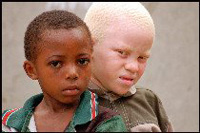Africa gripped with horrific killings of living ghosts
Their snow-white skin, thin blonde hair and nearly colorless eyes have earned them the reputation of living ghosts. Being publicly insulted is not something that albinos fear most. Their limbs and blood enjoy a very high demand in Tanzania. Albino individuals are being hunted for like animals. Shamans use albinos’ body parts in their religious rituals. Sorcerers are ready to pay big money for albinos’ limbs and blood in the African country.

Attacks on albinos do not surprise local residents in Africa anymore. A group of men broke into a hut of a woman in the Mwanga District near Kilimanjaro. The men brutally slaughtered the woman’s daughter, who was an albino. They used a machete to chop off the child’s legs. Then they slit the girl’s throat, poured her blood into a pot and drank it.
The woman, named only as Salma, was told by her family to dress her baby in black and leave the child in the hut alone. The woman did not understand the point of the request, but obeyed the elders.
Another horrific killing of an albino was reported near the Republic of Congo. A man was arrested there when the police found the head of an albino child in his luggage. The man said that he was promised to receive a good reward for the trophy.
A crowd wielding machetes attacked a 13-year-old albino girl Elizabeth Hussein. Her limbs were then found in the house of a local shaman.
Thirty-five albino people have been slaughtered in Tanzania in 2008 alone. The population of the poverty-stricken country follows religious prejudices, the beliefs in witchcraft, rituals and fortune-telling are very strong there. Tanzanian witch doctors believe that albinos’ limbs can make their incantations stronger. Local fishermen believe that they will catch more fish if they weave albinos’ hair into nets. A potion made from body parts of an albino costs a hefty amount at Tanzanian gold mines.
The beliefs make it very hard for an albino individual to find a job in the country, whereas albino children need to be watched and guarded 24/7 not to be hacked to death.
Death may not be the end for an albino in Tanzania . Heavy tombstones need to be mounted of albinos’ graves not to let “hunters” steal the bodies.
The gene that weakens the normal skin pigmentation appears in Africa a lot more frequently than in the rest of the world. One of 3,000 people may have albinism there, whereas the correlation is different for other continents – 1 of 20,000 people.
Albinism is a form of hypopigmentary congenital disorder, characterized by a partial (in hypomelanism, also known as hypomelanosis) or total (amelanism or amelanosis) lack of melanin pigment in the eyes, skin and hair (or more rarely the eyes alone). Albinism results from inheritance of recessive alleles. The condition is known to affect mammals (including humans), fish, birds, reptiles and amphibians.
Albinism is hereditary; it is not an infectious disease and cannot be transmitted through contact, blood transfusions, or other vectors. The principal gene which results in albinism prevents the body from making the usual amounts of the pigment melanin. Most forms of albinism are the result of the biological inheritance of genetically recessive alleles (genes) passed from both parents of an individual, though some rare forms are inherited from only one parent. There are other genetic mutations which are proven to be associated with albinism. All alterations, however, lead to changes in melanin production in the body.
The chance of offspring with albinism resulting from the pairing of an organism with albinism and one without albinism is low, as discussed in more detail below. However, because organisms can be carriers of genes for albinism without exhibiting any traits, albinistic offspring can be produced by two non-albinistic parents. Albinism usually occurs with equal frequency in both genders. An exception to this is ocular albinism, because it is passed on to offspring through X-linked inheritance.
Subscribe to Pravda.Ru Telegram channel, Facebook, RSS!




